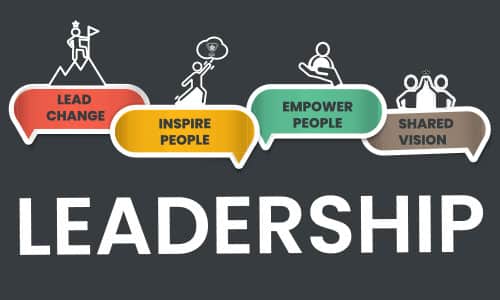When to Manage and When to Lead?

Many articles talk about the difference between the activities of management and leadership. Many times, these articles make it sound like leadership is just a little bit better – a higher ideal to aspire to. Managers keep the trains on track and keep a tight watch over their teams. Leaders are visionary and inspire the organization towards a brighter future.
This article takes a slightly different view, and talks about when management, leadership, or both are most needed based on the situation. We also look at success factors for both managers and leaders, and some characteristics that may differ between the two activities of management and leadership.
SAVE $10 AND TRAIN ON THIS TOPIC TODAY
Common Skill Sets: Management and Leadership
Let’s look at some characteristics and skills that are needed by people doing both management and leadership activities or roles.
- Emotional Intelligence: Successful management and leadership require strong emotional intelligence. Both managers and leaders recognize and manage their own emotions – also called self-awareness and self-regulation. They also recognize the emotions of other people and teams. This is empathy. Mangers and leaders generally have good social skills, regardless of the organizational level being worked at – this means they effectively build and maintain relationships over time.Emotional intelligence also includes adaptability and resilience – and this is needed at all levels of management and leadership. For example, managers need to adapt and bounce back when things go wrong on a project; organizational leaders need to adapt and recover when the stock price tanks or there is a major public crisis. Even leaders in work groups without formal authority must adapt and maintain their internal drive and spirit over time.
- Communication Skills: Communication skills are critical for workplace success, regardless of whether the activities are traditionally considered management or leadership. Leaders must communicate a vision and overarching strategy. Managers must communicate work tasks, resources, success metrics and deadlines.Both leaders and managers must actively listen to the people around them, coach and mentor others, manage conflict and provide feedback in a constructive and sensitive way. Communication also includes motivating others and using rewards and recognition to keep teams and organizations focused on the right path.
- Honesty and Integrity: Both managers and leaders need to follow the highest standards of ethics, honesty, transparency and consistency. This does not mean sharing everything one knows, but it does mean sharing what you can when you can and staying true to your word. Both managers and leaders may need to flex their behaviors to meet a situation, but overall, people should be able to anticipate the manager’s or leader’s values and general approach – that is authenticity and consistency. Both are essential for building and maintaining trust.
- Strategic Thinking: Strategy is often the bridge between leadership and management. Visionary leaders are most effective when they can translate a vision into strategic priorities for the future. Managers are most effective when they can strategically see how the daily work is supporting larger goals – and can shape decisions and projects to achieve something greater than was initially defined.
Targeted Skills for Managers
Management is generally associated with activities that involve getting things done. This may include managing a production line or operations, managing a service or support area for an organization, or managing programs and projects. Management is also appropriate when leading people who need more structure and guidance on how to deliver outcomes from day-to-day tasks. This may include junior and mid-level staff, or workers who need more ongoing oversight.
Managers absolutely need leadership skills to serve their teams and organizations, but there are also specific skill sets that go with running the daily activities of a group or program. Here are examples.
- Problem Solving: Most managers spend most of their day solving problems. Successful managers are skilled problem solvers. They can identify issues quickly, analyze the drivers, determine the criteria for successful solutions, think creatively to identify options and take action to resolve them. These are concrete and pragmatics skills that drive organizations every day.
- Decision Making: Solving problems also involves making decisions – but there does not need to be a problem for a decision to be needed. Effective managers know what information they need to make a decision, the criteria to use to weigh the alternative and the impacts of the decision made. Good managers are decisive when they need to be – and know when to wait until more information is available. This also involves having the courage to make tough decisions when necessary.
- Delegation: Being able to identify tasks, projects, or activities to assign to others – and the process and people savvy to see them through – lies at the heart of effective managements. Good managers know how to distribute work across multiple people, while maintaining role clarity, coverage so that all elements are addressed and good process management so people know how they fit in with the overall picture. Good managers know the strengths, abilities and development needs of their teams, so they can both maximize impact and provide stretch opportunities where appropriate. This increases productivity and helps the team grow and develop.
Targeted Skills for Leaders
Leadership is generally associated with activities that involve shaping the future. The term “leader” is often used to refer to people more senior in an organization – the people who define the vision and strategy. The interesting thing about leadership is that it can be exercised by anyone in an organization who has the courage to move things forward. Asking a good critical question that no one has asked before, and that shapes the thinking of a group is leadership – and anyone can do it.
Here are some specific skill sets that go with leadership that shapes the future:
- Vision: Successful leaders have a clear, exciting idea of where they are going and what the future could look like. They have a way of seeing the future and communicating in a way that gets other people to follow.
- Innovation: Leaders are generally known to be open to new ideas and embrace change. They look for better ways to achieve goals – even when it has not been tried before. This may mean taking an idea or practice that has worked in one place and applying it to another – or producing something entirely new.
- Humility: Good leaders will work with whoever they need to move a system – as noted above, leaders can be anywhere in the organization chart – this is a key difference with what we typically see as management. While good managers are often open and humble, humility itself is a leadership-focused trait.
- Cooperation and Empowerment: Successful leaders work systems to bring people together outside traditional groups and across boundaries. They understand the importance of bringing together people who may not work together – and engaging them to look to the future in different ways. Leaders empower others by providing opportunities, connections and confidence.
Common Differences Between Management and Leadership
Now that we have looked at shared and different skill sets for managers and leaders, let’s do some side-by-side contrasts. Again, we are looking at these differences more through the lens of activities instead of individual people themselves.
- Vision vs. Execution: Leaders often focus on creating and communicating a vision, inspiring people to believe in and strive for that vision. Managers are focused on executing the vision, putting the processes and systems in place to achieve the actual outcomes and deliverables needed to demonstrate that the vision has been met.
- Risk-taking – Transformation vs. Risk Management – Maintenance: Leaders are often seen as risk-takers, willing to propose and pursue innovative or untested solutions to transform or push things forward – often this is done to set a direction or communicate a future state, and may or may not come with formal accountability for an outcome. Managers tend to be in roles that focus on risk management, ensuring stability and predictability. Now certainly, managers must take calculated risks to get things done – but it is just that – calculated. Delivery comes first.
- Future Orientation vs. Present Orientation: This is a common way to distinguish leadership and management. Leaders are typically future-oriented. They think about the long-term goals, strategies and the overall direction of the team or organization. Managers, in contrast, tend to be more present-oriented, focusing on the current tasks, immediate team needs and day-to-day operations.
Pryor offers many online and in-person trainings on Management and Leadership to develop all the skills described above. Our training offerings in leadership, management, supervision, emotional intelligence, project management and communications range from short videos to full-day in-person seminars to on-line webinars depending on your learning style and availability. Here are some good examples:
- Managing Multiple Priorities, Projects and Deadlines.
- Developing Emotional Intelligence.
- Strategic Thinking and Planning
- Strategic Goal-Setting
Many people can and do show both leadership and management qualities – sometimes every day. The best leaders manage well – and the best managers lead. Both activities and people are crucial for a successful organization.





